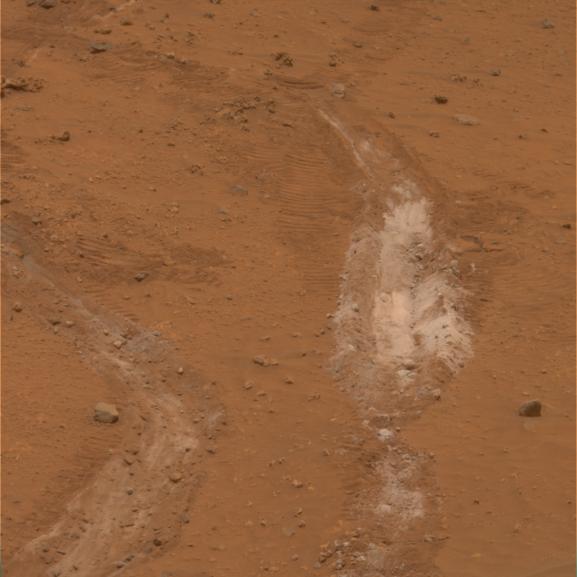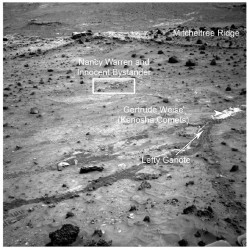Spirit’s gimpy right front wheel has turned out to be a blessing in disguise. The Mars Exploration Rover traversing around the Gusev Crater region on Mars has been forced to drive in reverse, dragging the jammed wheel behind. But that wheel gouged a trench a few inches deep through the Martian soil, revealing deposits of nearly pure silica that scientists believe formed when volcanic steam or hot water (or maybe both) percolated through the ground. Such deposits are found around hydrothermal vents like those in Yellowstone National Park, and when active, usually teem with life.
The silica, discovered in 2007 and announced briefly then by NASA, has now been further examined by the rover’s Miniature Thermal Emission Spectrometer and the Alpha Particle X-Ray Spectrometer. A new paper in the journal Science describes the findings, lead by Steven Squyres, principal investigator for the rover science payload.
The silica finding turns a spotlight on an important site that may contain preserved traces of ancient Martian life. But since the rovers don’t carry instruments that can detect microscopic life, for now the site can only be classified as a once habitable environment where liquid water and the energy needed for life were present. This area would be a prime location for a future mission capable of searching for ancient biological evidence.
Although the trench was created and briefly studied last year, further examination of the site and the surrounding area had to wait while Spirit entered a hibernation mode for a few months in an attempt to survive its second Martian winter. The rover spent those months on the edge of a football-field-size feature called Home Plate.
Now that Spirit has been moving around again, the rover has found the silica in a wide area.
“It’s not just the soil in a trench in one place,” said Steve Ruff, a co-author of the paper. “It’s a broader story of outcrops that extend 50 meters [about 150 feet] away from Home Plate. It’s not a small scale, modest phenomenon.”
In some areas the soil is nearly 90% silica.
Making such pure silica requires a lot of water, says Ruff. “On Earth, the only way to have this kind of silica enrichment is by hot water reacting with rocks.” In other words, a Yellowstone-like environment that would include a combination of geothermal heat and water produced by a hydrothermal system like the one which powers the hot springs, geysers, mudpots, and fumaroles (steam vents) of Yellowstone National Park.
Astrobiologist Jack Farmer explains that hydrothermal systems generally precipitate silica and other minerals as heated groundwater rises, cools, and gives off dissolved gases. “If there were organisms living there,” he says, “our terrestrial experience shows that microbes can easily be entrapped and preserved in the deposits.” Silica, he notes, is an excellent medium for capturing and preserving traces of microbial life.
NASA landed the two Mars rovers, Spirit and Opportunity, on opposite sides of the planet in January 2004 to look for rocks showing the presence of water. As of now, the rovers are more than four Earth years into a mission designed to last just three months. Despite dust collecting on their solar panels and mechanical wear-and-tear, both are continuing to explore.
Original News Source: ASU



I’m guessing the next Mars Rover will incorporate a plough attachment! =-)
Call Mr. Plow, that’s the name… That name again is Mr. Plow!
# RapidEye Says:
May 22nd, 2008 at 12:33 pm
“I’m guessing the next Mars Rover will incorporate a plough attachment! =-)”
Yeah…
Maybe they need to incorporate a bung wheel in all future rover designs… Mars Science Laboratory engineers – take note!
I’m with the one man one way deal except it”ll be a one monkey one way deal, and for all you animal lovers just think of this if its not the monkey it’ll be your uncle or brother or father or son.